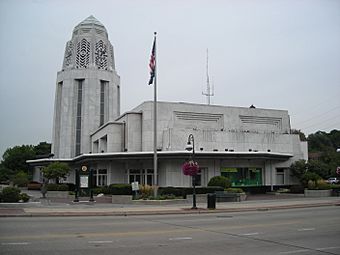St. Charles Municipal Building facts for kids
Quick facts for kids |
|
|
St. Charles Municipal Building
|
|
 |
|
| Location | 2 East Main St. St. Charles, Illinois, United States |
|---|---|
| Area | less than one acre |
| Built | 1940 |
| Architect | R. Harold Zook and D. Coder Taylor |
| Architectural style | Art Deco or Moderne |
| NRHP reference No. | 91000087 |
| Added to NRHP | February 21, 1991 |
The St. Charles Municipal Building is a historic and important building in St. Charles, Illinois. It was built in 1940 and given as a gift to the city. Since then, it has been the main place where the local government works. This special building was added to the National Register of Historic Places in 1991.
Contents
A Special Building for St. Charles
The St. Charles Municipal Building is known for its unique look. It was designed to be a lasting and beautiful landmark for the city. It shows how important good design was back in the 1940s.
How the Building Came to Be
The building was designed by the architecture firm of R. Harold Zook in Chicago. Zook worked closely with his nephew, D. Coder Taylor. Taylor started working for his uncle in 1935. He remembered that they took on many different projects. Taylor said his uncle was very good at getting new jobs. He called the St. Charles Municipal Building a "big project" for their office.
Designing a Unique Look
At first, Zook made a drawing for the building. But the person paying for the building wasn't very impressed. They wanted something more modern and striking. So, D. Coder Taylor took over the design. He made all the new drawings for the project.
Taylor explained that even though his uncle was the main architect, they worked together. They would discuss ideas and make changes. This teamwork helped make the final design perfect. The building's style changed to a more "Art Deco type of design."
The building was a gift to St. Charles from a wealthy person named Colonel E. J. Baker. He had inherited a lot of money. Colonel Baker's niece, Dellora, and her husband, Les Norris, gave the land for the building. This land was along the Fox River. Colonel Baker then paid for the building itself.
He wanted the building to be made of strong, beautiful marble. He chose white Georgia marble. D. Coder Taylor even went to Georgia to pick out the marble. Both Colonel Baker and Taylor wanted the building to last a very long time. They wanted it to look good for many years to come.
Colonel Baker had a clear idea of what he wanted. He didn't want the city's mayor or other officials to be involved in the design. He wanted to build the entire building and then give it to the city when it was finished. The architects had to research what a city hall needed. Colonel Baker also wanted a special wing for a historical museum.
The city was very happy to receive the building. D. Coder Taylor said that they designed and oversaw the building's construction without talking to city officials. The Municipal Building is now a very important and well-known landmark in St. Charles. It was added to the National Register of Historic Places in 1991 because of its special architecture and engineering.
What Makes Its Design Special?
The building's design was inspired by the Art Deco movement. However, its style is often called Moderne. This is because it was built after 1930. Buildings from this time often had fewer decorations. Their windows were grouped together in long bands.
The outside of the building features white Georgia "Cherokee" marble. It also has a base made of black granite. You can see cool patterns like zigzags, chevron shapes, and octagon shapes. These are common in Art Deco and Moderne styles.
Inside the Building Today
The Municipal Building has been used as the main government office in St. Charles since it opened in 1940. In 1995, a new entrance was added. This new part included an elevator. This was done to make the building easier for everyone to use, following the Americans With Disabilities Act. This new section also connected the Municipal Building to the older City Building from 1892.
Over the years, the city has made more office spaces inside the building. The St. Charles History Museum used to be in the building. But in 2001, it moved to a historic gas station building nearby.



